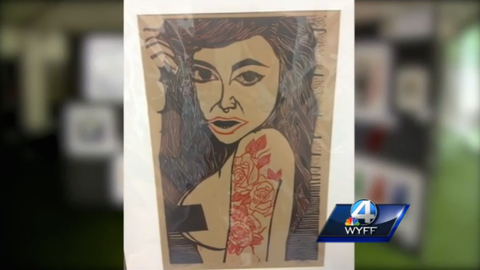High Schooler's art tries to change rape culture, school tells her no thanks
High Schooler's art tries to change rape culture, school tells her no thanks

Gracie Holtzclaw, a high school senior from South Carolina, entered a county-wide school art exhibition. Her artwork titled, Rape Culture which should have inspired positive dialogue between parents, teachers and students about the perils of victim blaming and purity culture, instead was banned at the last minute by the school after being deemed inapproprite. Her artwork was excluded on the grounds that children, not much younger than Holtzclaw herself, might see it. The artwork appears to be a block print of a barechested woman with a tattoo and her breasts censored.
In an interview with WYFF4, Holtzclaw revealed that her artwork came from a deeply personal experience:
“I started at an early age at a Christian school, locally, and we were always taught that it was our responsibility as women to cover up and be modest, and if a man was to ever get aroused or turned on or be interested in us, it was our fault,” said Holtzclaw. “Eventually, I had gotten sexually assaulted. It was true when it happened. Everyone blamed me for it and told me it was my fault and that just led the way into this art piece.”
What's incredibly important about Holtzclaw's artwork is that it becomes an activist source demanding awareness towards the unfairness and cruelty of victim blaming. It also becomes a beacon for others, like Holtzclaw who need to find courage through other outlets to speak up when they, too, experience an assault or need support. It is incredibly unfortunate that the school district or jurors put sexual prudity over the welfare of just not one student artist, but the power for her message to positively permeate to others and help change a school system rife with an unhealthy systen to deal with sexual assault. If topical artwork is not appropriate for public discourse according this particular South Carolinas school district, how does it expect to support survivors of rape?
“I know I’m not the only girl in high school that’s been sexually assaulted and felt like it was my fault, so I wanted to get the word out there and tell people, ‘It’s not your fault. It’s not your fault,’” said Holtzclaw. “Things that need to be talked about shouldn’t be taboo, because people struggle and we need to talk about those kind of things that people struggle with.”
This event comes just after Ms.'s recent Winter/Spring magazine, which covered how college and university systems are failing to protect victims of sexual assault. It revealed that many campuses are not creating a safe environment for survivors to report crimes (only 12% of college rape survivors will report, 2007 Campus Sexual Assault Study). Survivors don't feel adequately supported and safe after the event academically, physically and emotionally, nor to school's quell peer reprisal, such as victim blaming enough. The article also covered how few campuses find the perpetrators responsible; only 10-25% are expelled. With 1 in 5 college women experiencing rape or an attempted rape awareness is crucial, which makes Holtzclaw's powerful piece all that more important and her exhibition rejection all the more problematic.
Groups such as the SAFER (Students Active For Ending Rape), The Campus Sexual Violence Elimination Act (SaVE), Title IX complaints, student blogs (Covered in Band Aids, Project Unbreakable, Surviving in Numbers, and It Happens Here), and the Clery Act are just a few examples the article gave of groups actively focusing on changing and eliminating rape culture on college campuses. Even President Obama revealed in January a White House Task Force to Protect Students from Sexual Assault report and a video to help curb the culture. Though Holtzclaw's rejection brings to light whether high school needs to be included in this type of campus activism; afterall, if a proper education doesn't happen in grade school then these college groups will constantly fight an uphill battle.
A special note from a bunch of activist art broads to Gracie and young women like her, rejection in art is part of the profession. However, sometimes rejection can happen under certain situations that make the actual rejection far more powerful than being in the show. By not being included in a small regional show, your artwork, message and story has reached a far greater audience and raised awareness on a much needed issue in our education system. Your bravery and instinct to publically call out a faulty system was the right one. Using art to communicate your ideas and call for positive change makes you a part of a strong heritage of female activist artistst, a heritage that you should be very proud of. Brava!


